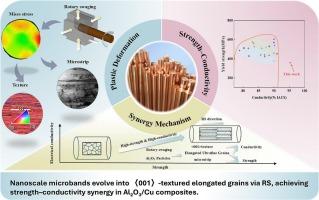Synergistic strength and conductivity enhancement via Induced 〈0 0 1〉-textured ultrafine grains in Al2O3/Cu composites
IF 7.9
2区 材料科学
Q1 MATERIALS SCIENCE, MULTIDISCIPLINARY
引用次数: 0
Abstract
Overcoming the strength–conductivity trade-off in Al2O3/Cu composites remains a key challenge. Here, we propose a microstructural design strategy that combines 〈0 0 1〉 texture with elongated ultrafine grains. Room-temperature rotary swaging (RS), assisted by the pinning effect of Al2O3 particles, promotes the selective formation of 〈0 0 1〉-oriented grains through compressive–shear deformation and enhances grain aspect ratios. The resulting structure provides texture-dominated conductive paths while reducing transverse grain boundary density. Consequently, the composite achieves a yield strength of 342 MPa and an electrical conductivity of 95.3 % IACS—representing a 56.8 % strength increase over the Cu matrix without sacrificing conductivity. This work demonstrates a scalable, room-temperature route to high-performance Cu-based composites with an exceptional strength–conductivity balance for advanced electrical applications.

通过诱导< 0 0 1 >织构的超细晶粒增强Al2O3/Cu复合材料的协同强度和电导率
克服Al2O3/Cu复合材料的强度和导电性的权衡仍然是一个关键的挑战。在此,我们提出了一种结合< 0 0 1 >织构和细长超细晶粒的微结构设计策略。在Al2O3颗粒的钉住作用下,室温旋转挤压(RS)促进了< 0 0 1 >取向晶粒通过压剪变形的选择性形成,提高了晶粒的长径比。所得到的结构提供了织构主导的导电路径,同时降低了横向晶界密度。因此,复合材料的屈服强度为342 MPa,电导率为95.3%,在不牺牲电导率的情况下,比Cu基体的强度提高了56.8%。这项工作展示了一种可扩展的,室温的高性能铜基复合材料,具有卓越的强度-导电性平衡,适用于先进的电气应用。
本文章由计算机程序翻译,如有差异,请以英文原文为准。
求助全文
约1分钟内获得全文
求助全文
来源期刊

Materials & Design
Engineering-Mechanical Engineering
CiteScore
14.30
自引率
7.10%
发文量
1028
审稿时长
85 days
期刊介绍:
Materials and Design is a multi-disciplinary journal that publishes original research reports, review articles, and express communications. The journal focuses on studying the structure and properties of inorganic and organic materials, advancements in synthesis, processing, characterization, and testing, the design of materials and engineering systems, and their applications in technology. It aims to bring together various aspects of materials science, engineering, physics, and chemistry.
The journal explores themes ranging from materials to design and aims to reveal the connections between natural and artificial materials, as well as experiment and modeling. Manuscripts submitted to Materials and Design should contain elements of discovery and surprise, as they often contribute new insights into the architecture and function of matter.
 求助内容:
求助内容: 应助结果提醒方式:
应助结果提醒方式:


